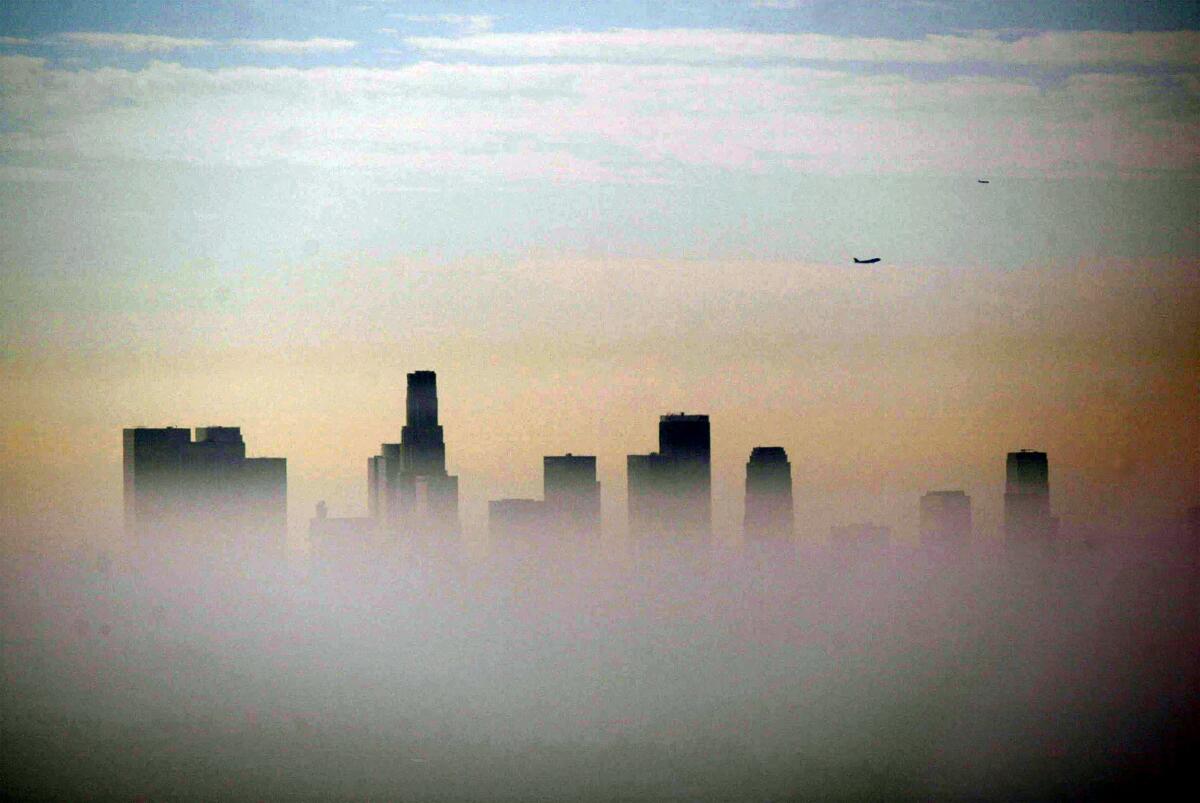Local air regulators say it’s impossible to meet smog standards without federal help

Southern California air regulators have approved a sweeping plan to reduce pollution in the nation’s smoggiest region within the next two decades, but say they cannot meet national air quality standards without federal action.
The South Coast Air Quality Management District governing board voted 9 to 2 on Friday to adopt a nearly 5,000-page plan that is expected to serve as a road map on how the air district expects to comply with the 2015 federal standard for ozone (the lung-aggravating haze commonly known as smog).
Within the voluminous report, the air district outlines dozens of potential measures that could reduce smog-forming nitrogen oxides and bring the region closer to meeting the 2015 ozone standard, which it is required to meet by 2037. But air district officials said these proposals alone would not help the region meet that target, and implored the U.S. Environmental Protection Agency to curtail pollution in ports, rail yards and airports — all of which fall under federal authority.
To meet the 2015 standard, nitrogen oxides — produced by the combustion of fossil fuels — must be limited to 60 tons a day across the air basin, according to estimates by air district officials. By comparison, 351 tons of nitrogen oxides were released each day in 2018, the last year the air district calculated these emissions. Only 14% of those were from fixed sources that the air district can regulate, such as refineries, power plants and buildings.
The California Air Resources Board has released its long-awaited scoping plan, a roadmap for the state to drastically cut its carbon emissions.
The California Air Resources Board is expected to considerably lower the mobile sources under its purview, recently approving a landmark ban on sales of new gas-powered cars by 2035.
However, even with existing rules at the state and local level, nitrogen oxideemissions are expected to fall to 184 tons a day by 2037, more than triple the 2015 ozone standard.
Around 46% of that is expected to be released from federal sources, including ocean-faring ships, locomotives, aircraft and interstate trucks.
Sources of pollution under state and regional authority “are becoming smaller and smaller, but the federal regulatory scheme has pretty much been stagnant on heavy-duty mobile sources,” said Sarah Rees, assistant deputy executive with the South Coast air district. “And so we really need the federal government to be able to step up. It’s simply not possible to be able to achieve the standard without federal government action — and substantial action at that.”
In April, the air district sent a letter to EPA Administrator Michael Regan threatening to sue the agency for violating the Clean Air Act, saying the federal agency had made the air district’s task impossible. The air district has still not filed a lawsuit, and the letter was largely seen as an attempt to compel the federal agency to the bargaining table.
However, the impasse continues.
Given the sizable gap in meeting the federal standard, the air district’s plan relies on controversial “black box” measures to achieve the remaining 61 daily tons of reductions. Because “extreme” non-attainment areas, such as the South Coast air basin, are typically given 20 years to meet federal targets, the EPA allows local governments to place a certain amount of needed reductions into a “black box” — a category that indicates authorities are relying on the future development of pollution-averting technology or reductions from the federal government.
The South Coast air district has relied heavily on these in the past and it remains a strategy that has drawn criticism from environmental advocates. In this year’s plan, 58 of the 61 tons in the “black box” were assigned to the EPA.
Officials at the ports of Los Angeles and Long Beach recorded an unprecedented surge in harmful emissions during 2021. They blame COVID-19.
If the air district can’t persuade the EPA to act on mobile sources, it has other workaround options. Last year, the air district adopted first-of-their-kind rules on large warehouse distribution centers, requiring the facilities to offset or mitigate pollution from truck traffic by implementing green measures, such as installing solar panels or paying mitigation fees.
The air district is expected to vote on similar regulations for rail yards and ports.
The air district plan details 49 potential measures that could help reduce nitrogen oxides and other pollutants, most of which focus on a suite of new building codes, industry rules and incentives for zero-emissions technology.
The plan calls for transitioning away from natural gas appliances in homes, such as water heaters, furnaces and stoves, and anticipates reducing nitrogen oxide emissions to 6.3 tons a day by 2037. Phasing out natural gas appliances in commercial buildings alone could eliminate nearly 8.5 tons a day.
For industrial sources, the air quality management plan suggests measures to reduce emissions from large refinery heaters and boilers by 20%. It also calls for developing a rule that would require local incinerators to use low-emission burner systems.
As wildfires become more extreme, some worry California will near a tipping point in which its forests emit more carbon dioxide than they absorb.
For the record:
3:12 p.m. Dec. 5, 2022A previous version of this story reported incorrectly that Larry McCallon voted against the air quality plan.
A number of representatives from industry or trade associations attended Friday’s meeting to express concerns about the expense of retrofitting buildings. Larry McCallon and Carlos Rodriguez, two air district governing board members, described the costs to homeowners as excessive.
“I’m still very concerned about the residential portion of this [plan] that deals with converting all of the appliances, etc., to zero emission,” McCallon said. “I think that’s going to have a negative impact on our lower-income communities and our seniors who live typically in older neighborhoods.”
Despite those concerns, McCallon voted to approve the air quality plan, while Rodriguez, along with fellow board member Janice Rutherford, voted against it.
Ben Benoit, chair of the governing board, acknowledged there were parts of the plan that still needed to be hashed out but emphasized that it was intended only to provide loose guidance for potential emission reductions.
“I recognize that this is a little aspirational,” Benoit said. “But I also recognize that this is not the final rulemaking for any of this, but a guide path to that rulemaking.”
However, their comments were rivaled by environmental leaders and members of heavily burdened areas, who asked board members to consider the potential health benefits, such as preventing 1,500 premature deaths each year and $19.4 billion in healthcare savings from prevented illnesses. From the Inland Empire to the Harbor Region, residents described how community members suffer from chronic headaches, nosebleeds and asthma attacks.
Marcos Lopez, a Long Beach resident and member of East Yard Communities for Environmental Justice, said residents are waiting for the day they won’t have to run air filters in their homes or wake up to soot on windowsills. And despite the many explanations about how that was a matter of federal attention, they asked for the air district to act.
“We need zero emissions now,” Lopez said. “It’s clear that the only worry freight industry has is the loss of profit. ... Our health is more important.”










